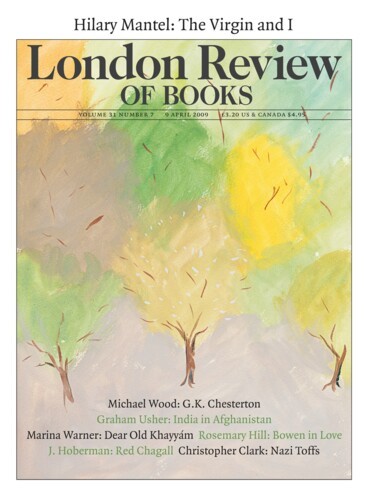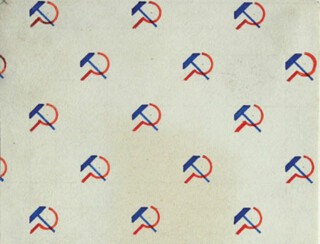Liubov Popova was only 35 when she died of scarlet fever in 1924. Osip Brik remembered her saying that ‘no single artistic success gave me such profound satisfaction as the sight of a peasant woman buying a piece of my fabric for a dress.’ Popova’s designs (mainly simple geometric patterns, but also a pretty one sprigged with a hammer and sickle motif, reproduced below) are among the mass of material – paintings, drawings, stage and costume designs, constructions, magazines, books, posters and advertisements – that fill the 12 rooms of Rodchenko & Popova: Defining Constructivism (at Tate Modern until 17 May). The material is lively, inventive and memorable, poignant even, because you know that early Russian modernism didn’t die a natural death but was cut down within a decade or so of its germination.
Popova’s pleasure reflects the constructivist belief that art would, or should, come to penetrate and transform every aspect of life, from architecture to poetry, from manufacturing to the theatre. That a severe version of abstraction with its origins in the isms of the prewar avant-garde could be a design tool integral to a new socialist society was not the most realistic notion bred by the Russian Revolution. The curator Margarita Tupitsyn’s account in the catalogue of the debates that took place in the years after the Revolution documents the high ambitions, intense arguments and divisive theories that the work can be used to illustrate.* These discussions are not easy to follow and taken on its own the work more often brings to mind an art deco cigarette case than a new vision of the place of art in work and life. But the paintings are often handsome, the drawings and constructions delicate and intricate, the pleasure in making things new palpable.
The sour joke was that while at home the constructivists were ousted by socialist realists, lost official backing, migrated into applied arts and didn’t achieve their high aims, abroad constructivism began a long afterlife as a quotable source. Modern architects mined it for ideas. Graphic artists used its conventions as a shorthand for ‘revolution’. Any document printed in black and red, illustrated with a photomontage and with sans serif type set at an angle, is probably a distant descendant of something by Rodchenko or Vladimir Tatlin. A 1917 design by Rodchenko for an aircraft hangar decorated in red, blue-black and yellow with a star and slogans reminds one of the folk art of conflict – Republican and Loyalist gable-end paintings in Belfast, for example. The visual style of the Red Army would never be that cheerful.
What was it like to live the constructivist life? The paintings tell us nothing, except what colours to give the works we see on the walls of studios and apartments in black and white photographs. Those photographs themselves tell a little more. The living-rooms and workspaces look tight, and you can imagine impassioned arguments among groups sitting close together around crowded tables. At the end of the exhibition there is a reconstruction of the library of the USSR Workers’ Club, as it was shown in the 1925 Exposition internationale des arts décoratifs et industriels modernes in Paris (Rodchenko’s design for it is shown abov). You can sit in one of the very uncomfortable, hard chairs and turn the pages of a book. The room is more aggressive than you imagine: the black and white photographs in the catalogue disguise the quantity of red paint.
And what, had its aims been achieved, would the constructivist world have been like? There wouldn’t have been paintings, because an art for the people would have so shaken and renewed the forms of bourgeois creation that the pictures shown here would be no more than discarded laboratory notes. (One reason Rodchenko and Popova went on making them was that they needed the money – in the early days state collections were buying modern pictures.) Visible social hierarchy would, of course, have disappeared; functional clothing would have replaced the class identifiers of suit, overalls and peasant costume. There are designs for rational clothing by Rodchenko and Popova (the one here is by Rodchenko). Narrative forms of film, writing and theatre would have undergone a transformation. Life itself – recorded as documentary film, the crowd becoming the audience for its own performances – would have taken over. There would no longer be a need for authorial invention. The avant-garde in Western Europe contemplated the dissolution of traditional forms; the constructivists, high on the experience of revolution, looked to melt the social matrix.
The acknowledgments thank a ‘new generation of Russian collectors who have finally expanded the hitherto minuscule coterie of native owners of these avant-garde pieces’ for the loan of seminal works: a reminder that the physical manifestations of the attempt to renew the relationship between art and the people are now herded into commercial galleries and auction rooms where markets make commodities of them. Perhaps it is a slip of the pen which has Tate Modern’s director, Vicente Todolí, say in his foreword that the heart of the exhibition is ‘the creative dialogue of the two most significant artists of the 20th century and their fundamental conviction in the potential of utopian abstraction to transform everyday life.’ But even if you read it as ‘two of the’, and accept the suggestion that their ‘collaborative way of working and direct involvement in local industries has influenced 20th-century fashion, media, theatre and cinema’, you would also want to say something about failed hopes and unsustained ambitions. Popova and Aleksandr Vesnin’s 1921 design for ‘The Struggle and Victory of the Soviets’, a ‘mass spectacle’ intended to celebrate the Third World Congress of the Communist International, was never used: the spectacle failed to take place because of ‘new control over street activities’. Although Popova’s fabric designs were successful, rational clothing never took off, and she doesn’t seem to have worn it herself. The relationship between the constructivists and the people has the sadness of unrequited love. Too much was being asked of them.
Send Letters To:
The Editor
London Review of Books,
28 Little Russell Street
London, WC1A 2HN
letters@lrb.co.uk
Please include name, address, and a telephone number.


